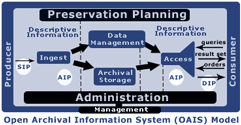The OAIS reference model diagram has become the most recognizable conceptualization of a system that addresses digital preservation, but the complete document is often overlooked. It contains six sections and six appendices that provide information vital to organizations trying to implement an "OAIS-compliant" digital archive. The document also lays out areas that are the focus of additional work by the OAIS working groups.
OAIS Contents
- Introduction
- OAIS Concepts
- OAIS Responsibilities
- Detailed Models
- Preservation Perspectives
- Archive Interoperability
Annexes:
A. Examples of Existing Archives
B. Relationships with Other Standards or Efforts
C. Brief Guide to the Unified Modeling Language
D. Informative References
E. A Model for Software Use in Representation Information
F. Composite Functional View
Highlights to note:
- The brief discussion of conformance in Section 1.4 provides an important key to implementation. A conforming implementation:
- will support the model in 2.2.
- will fulfill the responsibilities in 3.1, possibly using sample mechanisms suggested in Section 3.2.
- Otherwise, the OAIS reference model:
- does not endorse or recommend a specific implementation on any level, e.g., platform, environment, methodology.
- may provide additional services beyond OAIS required services.
- is a conceptual model for discussion and comparison.
- The road map for developing related standards in Section 1.5 identifies areas that may need to be defined and coordinated within the OAIS context.
- The terminology portion in Section 1.7 and the definitions of concepts in Section 2 are essential to understanding and using the OAIS reference model. These provide much more detailed information than can (or should) be represented on the high-level reference model and are the official source for definitions. The diagrams that accompany the concept definitions often make them much easier to understand.
- Section 3 defines the responsibilities of an OAIS in greater detail. A digital preservation repository must:
- negotiate for and accepts information
- obtain sufficient control for preservation
- determine the Designated and Consumer Community
- ensure information is independently understandable
- follow established preservation policies and procedures
- make the preserved information available
- Section 4 breaks down each high-level function into parts. For example, Preservation Planning requires one to:
- monitor the Designated Community
- monitor technology
- develop preservation strategies and standards
- develop packaging designs and migration plans
- The functional descriptions define the sub-functions with essential requirements for each. Section 4.1.2 contains a dataflow diagram for an OAIS, and Section 4.2 provides an extensive information model that became the basis for the preservation metadata work by RLG and OCLC and other standards development efforts.
- The Preservation Perspective discussion in Section 5.1, Information Preservation, offers subsections on migration types and processes, and Access Service Preservation, subsections touch on “look and feel” and emulation.
- Section 6 on Archive Interoperability makes some interesting distinctions between various archives models—independent, cooperating, and federated archives—and characterizes levels of autonomy in a subsection on management issues for federated archives.
- The examples of archives in Annex A are interesting and provide some helpful specifics of implementation work, but these need to be updated.
- The mapping of relationships to other standards documents the basis for some parts of the reference model and provides references to additional or relevant documents and initiatives. It also needs updating.
- The Unified Modeling Language (UML) was used in developing the OAIS model and a number of other object-based initiatives. Annex C is only a short summary of UML, but it provides a starting point.
- CCSDS has updated OAIS using both internal review and input from the user community.

